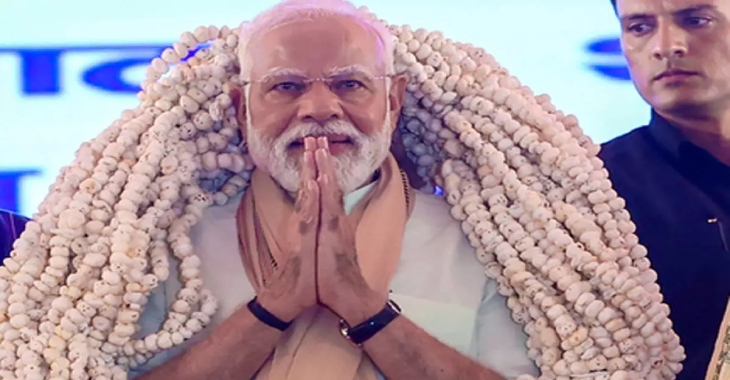Today is Prime Minister Narendra Modi’s 75th birthday. He was born in Mehsana town, Gujarat, on September 17, 1950, and held the position of Chief Minister for three times in a row from 2001 to 2014.
First elected in 2014, he is currently serving his third term as prime minister. In the past, PM Modi has used his birthday to engage with the public, introduce welfare programs, or participate in public activities. He has never thrown a party for himself. To demonstrate the PM’s dedication to the welfare of the populace, the BJP has, as it does each year, started the “Sewa Pakhwara” to commemorate his birthday.
Today, PM Modi is in Madhya Pradesh to introduce the “8th Rashtriya Poshan Maah” and “Swasth Nari Sashakt Parivar” initiatives. This is the nation’s biggest health outreach ever for women and children.
One of the many reasons PM Modi is loved is his deep regard for India’s history and culture. He is renowned for his passion for innovation for the country’s future.
Promoting innovation as the cornerstone of India’s journey is the driving force behind the PM’s essential vision for a Viksit Bharat in 2047. Under his direction, the nation is changing from a consumer of technology to a leader in the world, particularly in terms of innovation. Future innovations can now be contributed to by Indian scholars, universities, and companies thanks to this vision.
Prime Minister Modi has placed a great deal of focus on governance since assuming office in 2014. His government has made extensive use of technology in order to increase its efficiency. Today’s governance is driven by data-driven policymaking and digitally empowered technologies. It is now more efficient and has been able to reduce delays, red tape, and inefficiencies. There were grievances over the state delivery services being enmeshed in a maze of red tape and delays prior to PM Modi taking office.
The PM has directed authorities to eliminate all obstacles and swap out antiquated governance for a solution that is focused on the needs of the people. He has frequently emphasized the necessity of making the most of technology in order to improve governance. Tech titans worldwide have acknowledged the use of technology. “I am a fan of PM Modi,” Elon Musk, the CEO of Tesla, previously declared.
The manner the country makes its payments is one of the most significant reforms that PM Modi has brought about. Millions of people’s lives have been made easier by the Unified Payments Interface (UPI), which has been an enormous success. The statistics for June 2025 could be used to gauge the success. UPI handled more than Rs 24.03 lakh crore in transactions throughout that month.
Not only did Indians greatly value his leadership during the COVID-19 pandemic, but so did foreign leaders. During those difficult times, the PM emphasized technology once more. The CoWIN platform became the industry standard for vaccinations. This platform made the process easy, and more than 950 million people received vaccinations.
Additionally, PM Modi has been advocating for programs related to semiconductors. He has emphasized the necessity of being self-sufficient and lowering dependency on imports. India’s semiconductor market is expected to reach USD 110 billion by 2030 as a result of numerous efforts being implemented. With an investment of Rs 4,600 crore, the government authorized four additional semiconductor facilities in August 2025. This increased the number to ten such projects, which would be dispersed among six states and improve India’s standing in the world market for semiconductors. According to the PM, semiconductors are the modern era’s digital jewels.
While discussing growth, innovation, governance, and technology during his 2014 campaign, he placed a great deal of focus on security. In those days, explosions happened all the time in India. It was easy for groups like the Indian Mujahideen to conduct operations.
But PM Modi gave the security services carte blanche and made it clear that he supports a zero-tolerance approach against terrorism. They eliminated groups like the Indian Mujahideen. Numerous explosions nearly reached zero.
It was also determined to battle all the way to the Naxalites under his command. The initial focus was on tracking down and stopping the funding. Infrastructure development in areas affected by naxalism was given a lot of attention. This includes communication and road development. People ceased aiding the Naxalites after they started to benefit.
These efforts also aided the security forces, which enabled them to more successfully confront the Naxalites. Additionally, the Modi administration made sure that state and federal agencies were properly coordinated. This contributed to the battle’s victory as well, and by March 2026, India is expected to be free of naxals.
Another tough stand taken was the abrogation of Article 370. It was important in terms of security, development, and integration. While the article was repealed, PM Modi, along with Union Home Minister Amit Shah and National Security Advisor Ajit Doval, ensured that calm prevailed in Jammu and Kashmir. It was finally achieved, and the outcome was improved tourism, no stone pelting, development, and, more crucially, the end of separatist.
Questions were raised over the absence of action against Pakistan following the 26/11 attacks in Mumbai. But after the Uri attack, India launched a surgical strike under PM Modi’s direction. Following the Pulwama assault, a Jaish-e-Mohammed facility was the target of the Balakot airstrike. This time, the Indian Air Force struck the site after entering Pakistani airspace.
Operation Sindoor served as the response to the Pahalgam incident. India struck targets in Pakistan and Pakistan-occupied Kashmir. The major Lashkar-e-Taiba training site and the Jaish-e-Mohammed headquarters were among the targets that the Indian military destroyed in a 30-minute assault. A significant portion of Masood Azhar’s family was also destroyed by the operation.
India has advanced significantly in terms of innovation, governance, and technology under his direction.
As one officer had stated after the airstrike on Balakot. “The facility had been mapped 16 years ago by the Research and Analysis Wing, but it took courage to hit it.”
Read More


